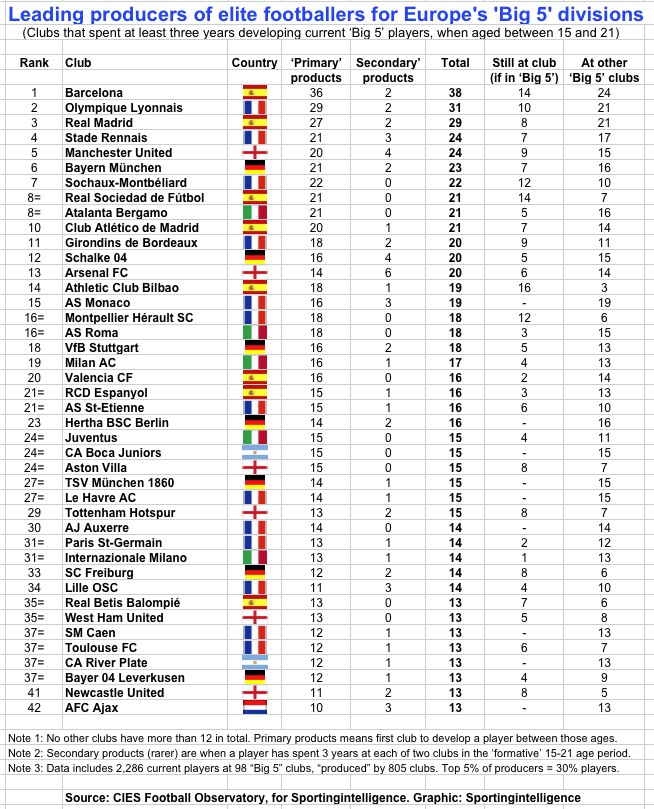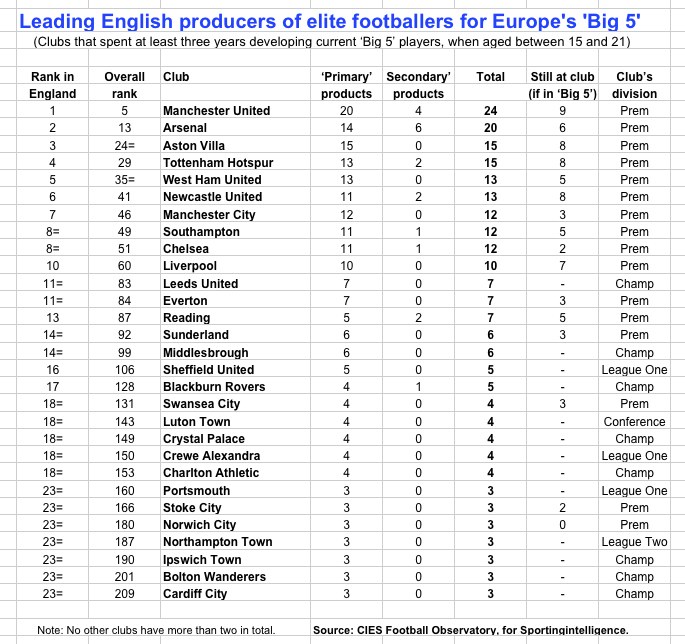REVEALED: Barcelona No1 for producing players for clubs in Europe’s elite leagues
Barcelona have produced more footballers currently earning a living as first-team players across Europe’s elite ‘Big 5′ divisions than any other club in the world, Sportingintelligence can reveal.
The Spanish giants have been responsible for the development of 38 players at top-flight clubs in either Spain’s La Liga, England’s Premier League, Italy’s Serie A, Germany’s Bundesliga 1 or France’s Ligue 1.
The definition of ‘produced’ for these purposes means that a player spent three or more years within the development programme of the club in question specifically between the ages of 15 and 21, which are considered a footballer’s most important ‘formative’ years.
The vast majority of players can cite one club where they were developed. In the case of this study, the backgrounds of 2,286 players at the 98 ‘Big 5′ clubs have been considered. Of those, 2,170 were ‘products’ of one specific club and the rest (116) can be attributed to two clubs developing the player for three years each during the formative period.
The data for this study comes from the CIES Football Observatory in Switzerland. For more details about them, see the foot of this article.
In total, 805 different clubs around the world from all levels of football have ‘produced’ at least one of the 2,286 players each.
Of Barcelona’s 38 players, 36 of them had Barca as their ‘primary producer’, or in other words Barca were the first club where they spent three or more years between 15 and 21. They include Lionel Messi, Andres Iniesta and Carles Puyol among others.
Fourteen of the 38 are still with Barca while 24 play elsewhere, including Chelsea’s Oriol Remeu, Liverpool’s Pepe Reina and Arsenal’s Mikel Arteta.
Two of Barca’s 38 ‘products’, Isaac Cuenca and Cristian Tello, are counted as ‘secondary’ products having been previously been with CF Reus and Espanyol respectively. Barca have nonetheless also had them for the requisite period.
After Barcelona, the most prolific producers of talent for the ‘Big 5′ are Lyon of France (31 players), Real Madrid (29), Rennes (24) and Manchester United (24).
Those top five clubs (of 805, or 0.6 per cent) have produced six per cent of the players, or 10 times as many as is ‘typical’.
The top 42 clubs (of 805, or five per cent) have produced 30 per cent of the players.
The top 42 and the breakdown of the players they have produced is in this first graphic.

Manchester United have produced more players than any other English club for the 98 clubs currently in the ‘Big 5′ divisions: 24 of them, nine of whom are still at United (including Evans, Giggs, Cleverley, Scholes and Welbeck) and 15 of whom playing elsewhere, from Phil Neville at Everton to Kieran Richardon at Fulham, Ron-Robert Zieler at Hannover 96, Paul Pogba at Juventus and Ryan Shawcross at Stoke City.
Four of United’s 24 products are ‘secondary’ products, with United playing a key role in developing them after another club had had them for an earlier chunk of the 15-21 formative years. These four are the Da Silva brothers, Wayne Rooney and Cristiano Ronaldo.
The second graphic isolates only the top English teams in terms of producing players currently in the ‘Big 5′.
United are followed by Arsenal (20), Aston Villa (15) and Tottenham (15) then West Ham and Saudi Sportswashing Machine (13 each) and Emirates Marketing Project, Southampton and Chelsea (all 12).
Notable in this graphic is how some key lower-league clubs have punched well above their weight to produce players for elite clubs. Luton Town of the Conference produced players now at Southampton, West Ham, Wigan and Norwich, for example, while Crewe have produced players now earning their corn at Manchester United, Aston Villa, Sunderland and West Brom.

It should be stressed: these figures only relate to current first-team players in the ‘Big 5′ divisions in Europe; players who were at the ‘producing’ clubs for at least 3 years between 15 and 21, and have played league football for one of the current 98 clubs this season.
Sportingintelligence has a separate research project underway to assess which clubs have produced the most professionals within the English game (all four main divisions), and is exploring ways to broaden this to discover which clubs globally produce the most players for the professional industry as a whole. This may take some time!
http://www.sportingintelligence.com/2012/12/13/revealed-barcelona-no1-for-producing-players-for-clubs-in-europes-elite-leagues-131201/
Barcelona have produced more footballers currently earning a living as first-team players across Europe’s elite ‘Big 5′ divisions than any other club in the world, Sportingintelligence can reveal.
The Spanish giants have been responsible for the development of 38 players at top-flight clubs in either Spain’s La Liga, England’s Premier League, Italy’s Serie A, Germany’s Bundesliga 1 or France’s Ligue 1.
The definition of ‘produced’ for these purposes means that a player spent three or more years within the development programme of the club in question specifically between the ages of 15 and 21, which are considered a footballer’s most important ‘formative’ years.
The vast majority of players can cite one club where they were developed. In the case of this study, the backgrounds of 2,286 players at the 98 ‘Big 5′ clubs have been considered. Of those, 2,170 were ‘products’ of one specific club and the rest (116) can be attributed to two clubs developing the player for three years each during the formative period.
The data for this study comes from the CIES Football Observatory in Switzerland. For more details about them, see the foot of this article.
In total, 805 different clubs around the world from all levels of football have ‘produced’ at least one of the 2,286 players each.
Of Barcelona’s 38 players, 36 of them had Barca as their ‘primary producer’, or in other words Barca were the first club where they spent three or more years between 15 and 21. They include Lionel Messi, Andres Iniesta and Carles Puyol among others.
Fourteen of the 38 are still with Barca while 24 play elsewhere, including Chelsea’s Oriol Remeu, Liverpool’s Pepe Reina and Arsenal’s Mikel Arteta.
Two of Barca’s 38 ‘products’, Isaac Cuenca and Cristian Tello, are counted as ‘secondary’ products having been previously been with CF Reus and Espanyol respectively. Barca have nonetheless also had them for the requisite period.
After Barcelona, the most prolific producers of talent for the ‘Big 5′ are Lyon of France (31 players), Real Madrid (29), Rennes (24) and Manchester United (24).
Those top five clubs (of 805, or 0.6 per cent) have produced six per cent of the players, or 10 times as many as is ‘typical’.
The top 42 clubs (of 805, or five per cent) have produced 30 per cent of the players.
The top 42 and the breakdown of the players they have produced is in this first graphic.

Manchester United have produced more players than any other English club for the 98 clubs currently in the ‘Big 5′ divisions: 24 of them, nine of whom are still at United (including Evans, Giggs, Cleverley, Scholes and Welbeck) and 15 of whom playing elsewhere, from Phil Neville at Everton to Kieran Richardon at Fulham, Ron-Robert Zieler at Hannover 96, Paul Pogba at Juventus and Ryan Shawcross at Stoke City.
Four of United’s 24 products are ‘secondary’ products, with United playing a key role in developing them after another club had had them for an earlier chunk of the 15-21 formative years. These four are the Da Silva brothers, Wayne Rooney and Cristiano Ronaldo.
The second graphic isolates only the top English teams in terms of producing players currently in the ‘Big 5′.
United are followed by Arsenal (20), Aston Villa (15) and Tottenham (15) then West Ham and Saudi Sportswashing Machine (13 each) and Emirates Marketing Project, Southampton and Chelsea (all 12).
Notable in this graphic is how some key lower-league clubs have punched well above their weight to produce players for elite clubs. Luton Town of the Conference produced players now at Southampton, West Ham, Wigan and Norwich, for example, while Crewe have produced players now earning their corn at Manchester United, Aston Villa, Sunderland and West Brom.

It should be stressed: these figures only relate to current first-team players in the ‘Big 5′ divisions in Europe; players who were at the ‘producing’ clubs for at least 3 years between 15 and 21, and have played league football for one of the current 98 clubs this season.
Sportingintelligence has a separate research project underway to assess which clubs have produced the most professionals within the English game (all four main divisions), and is exploring ways to broaden this to discover which clubs globally produce the most players for the professional industry as a whole. This may take some time!
http://www.sportingintelligence.com/2012/12/13/revealed-barcelona-no1-for-producing-players-for-clubs-in-europes-elite-leagues-131201/
